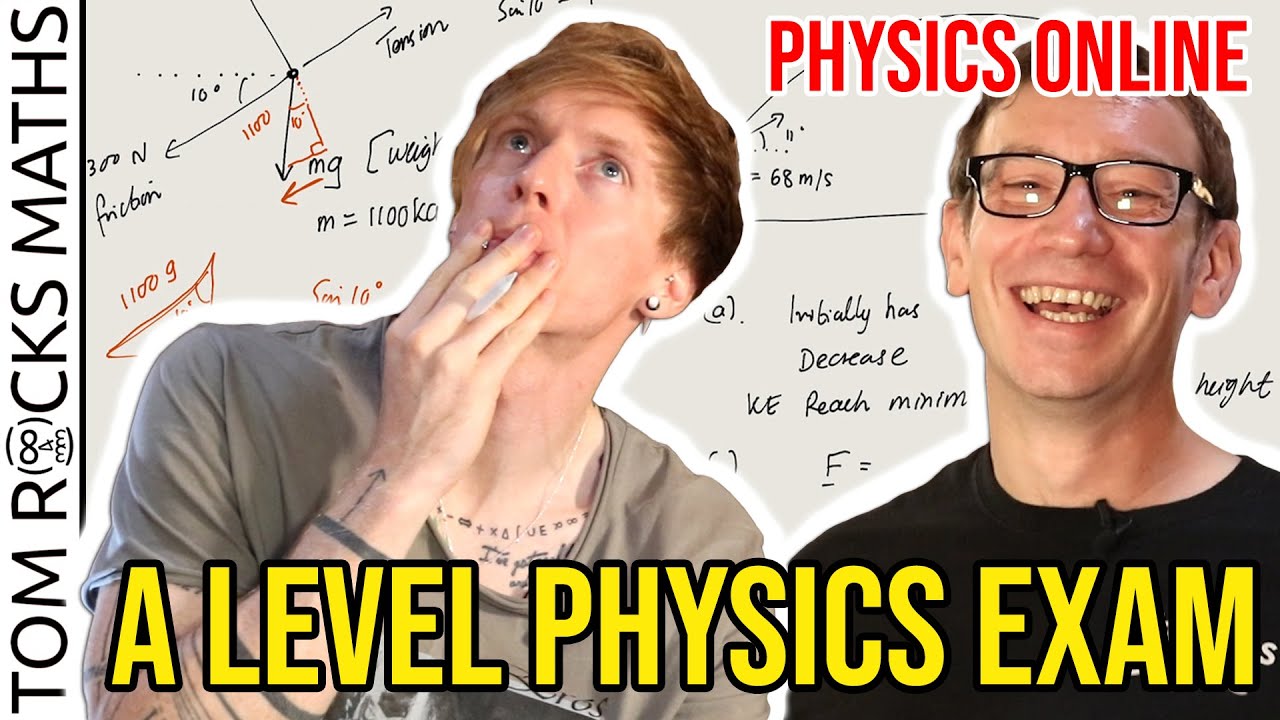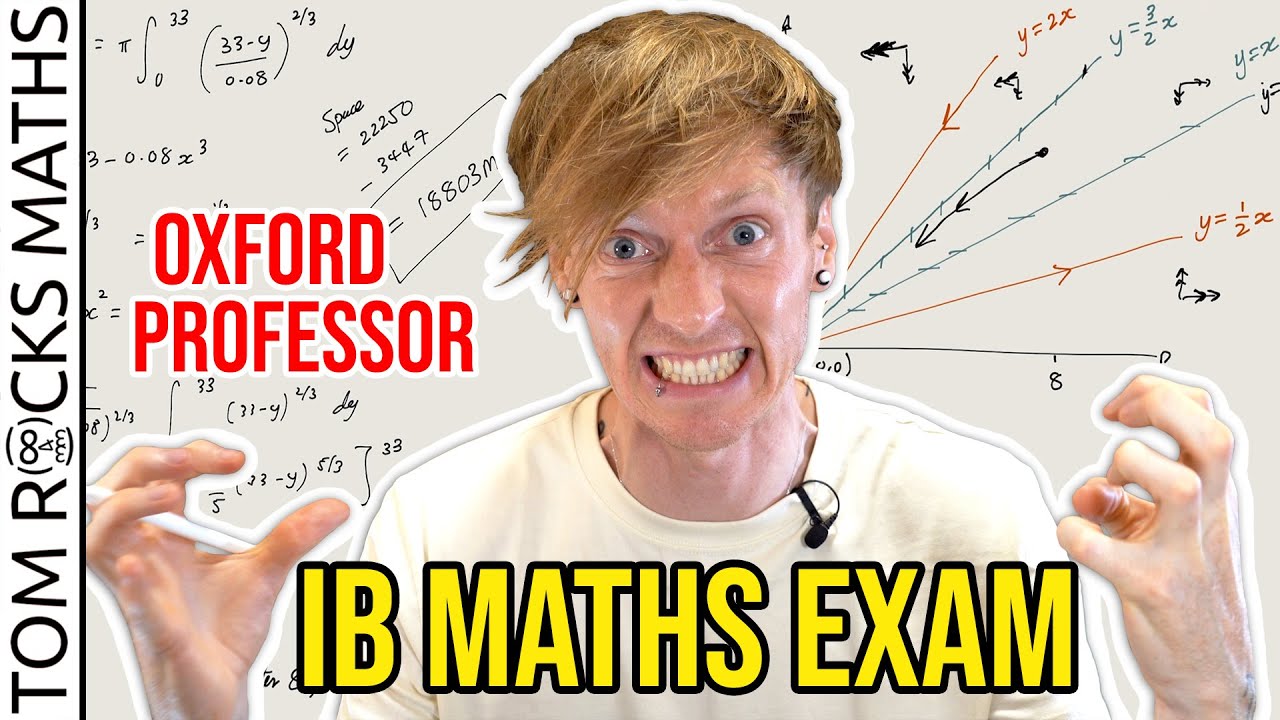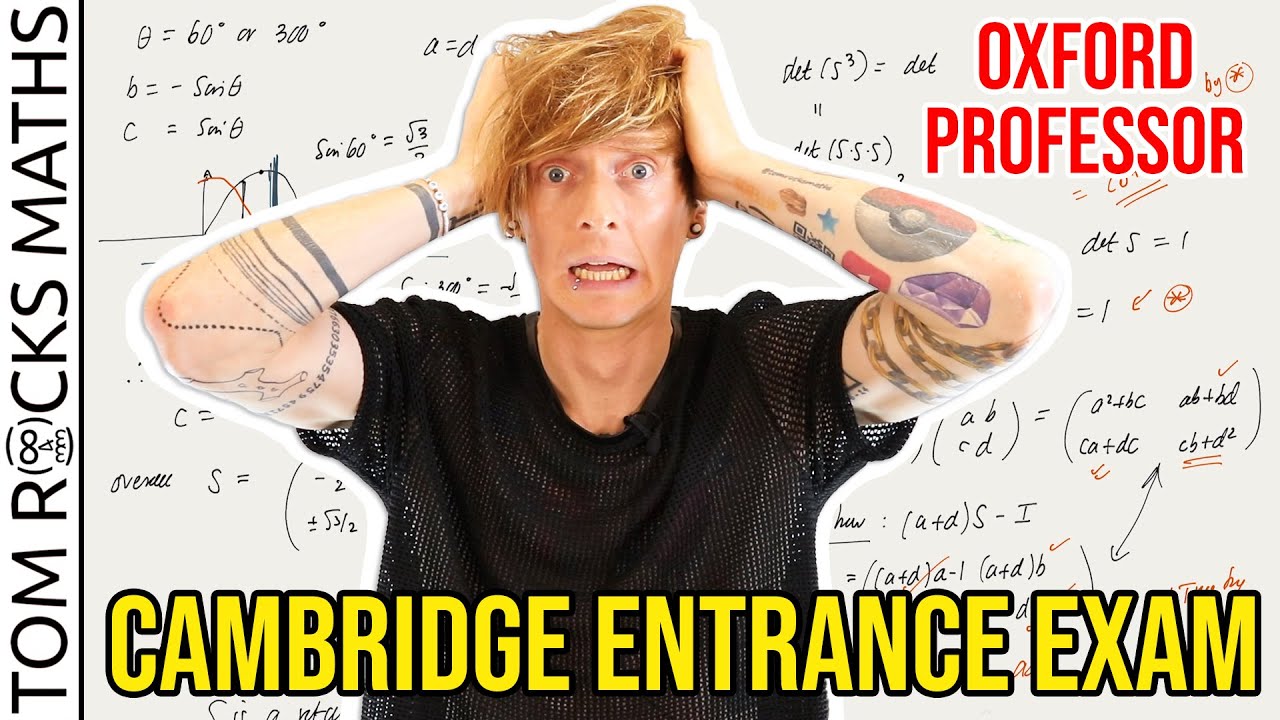Oxford Mathematician Challenges Physics Teacher to A Level Maths Exam
TLDRIn this engaging video transcript, a participant finds themselves at the University of Oxford, challenged to tackle A-level math problems by Lewis, the host of the channel 'Tom Rocks Math.' Tom, a mathematics educator at Oxford, humorously admits to being more experienced with physics than math at the A-level, having completed his A-levels over 23 years ago. The transcript details their collaborative approach to solving a variety of mathematical problems, including projectile motion, force equilibrium, and graph sketching. They employ different strategies, from mathematical physics equations to visual diagrams, to arrive at solutions. The session highlights the importance of understanding concepts versus memorizing formulas, the interplay between mathematical theory and real-world applications, and the value of visual representation in problem-solving. The conversation also touches on the changes in the A-level physics syllabus and the relevance of mathematical skills in higher education and various fields. The transcript concludes with a reflection on the experience, emphasizing the enjoyment and learning outcomes of engaging with mathematical challenges.
Takeaways
- 📚 The video features a collaboration between a math educator, Tom from Tom Rocks Maths, and a physics enthusiast, Lewis, as they tackle A-Level maths problems at the University of Oxford.
- 🏫 Tom is a maths teacher at the University of Oxford and also runs a YouTube channel dedicated to maths education, while Lewis is a physics enthusiast who challenges Tom to solve physics-related maths problems.
- 🔢 The transcript covers a range of maths topics, including projectile motion, vectors, forces, and graph sketching, with a particular focus on the application of these concepts in physics.
- 🎯 Tom demonstrates the use of mathematical principles such as the SUVAT equations (displacement, initial velocity, acceleration, time, and final velocity) to solve problems related to projectile motion.
- ✍️ The video emphasizes the importance of significant figures in mathematical answers and the convention of reporting answers to three significant figures.
- 🤔 Tom and Lewis discuss the differences in approach between mathematicians and physicists, highlighting the utility of physics intuition in certain problems and the precision required in mathematical solutions.
- 📈 The script illustrates the process of integrating and differentiating mathematical functions, which is a key skill in both maths and physics, and is used to find velocities and distances from forces and accelerations.
- 📐 Tom uses diagrams extensively to visualize problems, especially when dealing with vectors and projectile motion, which helps in understanding the direction and magnitude of various physical quantities.
- 🧮 The video script includes a detailed walkthrough of solving quadratic equations, which are fundamental in maths and often appear in physics problems involving energy and motion.
- 📉 The transcript also touches on graph sketching, an important skill in both subjects, and discusses how to interpret the intersection of two graphs to find real roots of equations.
- ⏱️ Time is a critical factor in the problems, with Tom calculating time taken for a ball to travel, the period at which forces are in equilibrium, and the time at which an object's velocity is zero.
- 📚 The session concludes with a reflection on the relevance of maths in higher education and its application in various fields, emphasizing the importance of continuous practice and understanding of mathematical concepts.
Q & A
What is the topic of discussion in the video?
-The video is about a challenge between Tom Rocks Math and Lewis, where they discuss and solve A-Level math and physics problems.
Why does Tom feel old when discussing his A-Level experience?
-Tom feels old because he completed his A-Levels in the year 2000, which is over 20 years ago, making him older than most viewers.
What is the significance of the number 23 years in the context of the video?
-The number 23 years is significant because it represents the time that has passed since Tom completed his A-Level maths, indicating the long gap since he last engaged with the material at that level.
What is the subject of the first problem they attempt to solve?
-The first problem they attempt to solve is a projectile motion question involving a golf ball.
What is the value of acceleration due to gravity that they use in the calculations?
-They use an acceleration due to gravity of 10 m/s^2 for their calculations.
What is the approach Tom takes to find the time taken for the ball to travel from the start point to the end point?
-Tom uses the principles of projectile motion, considering the vertical and horizontal components of the ball's velocity, and applies the kinematic equations to find the time taken.
What is the horizontal distance from A to B that they calculate?
-They calculate the horizontal distance from A to B to be approximately 42.3 meters.
What is the factor that could account for the difference between the calculated and actual horizontal distance of the ball?
-Factors that could account for the difference include the ball's spin, which could provide additional lift, and the potential influence of wind.
What is the method used to determine the value of T when the forces acting on the particle are in equilibrium?
-They set the sum of the constant force and the variable force equal to zero and solve for T, considering only the components of the forces that can balance each other out.
How does Tom approach the integration required to find the velocity and displacement of the particle?
-Tom reviews the process of integration, recalling the basic principles from his education, and applies it term by term to find the velocity and then the displacement of the particle.
What is the final question they tackle in the video?
-The final question they tackle involves graph sketching and determining the real root of an equation involving modulus and a quadratic expression.
Outlines
📚 Introduction to A-Level Maths Challenge at Oxford
The speaker is at the University of Oxford, challenged to complete A-Level maths problems. Tom from Tom Rocks Maths, a maths teacher at Oxford, is present. Initially, it was thought Tom would tackle physics questions, but it was discovered he hadn't done A-Level physics. Instead, they focus on maths, specifically a projectile motion question involving a golf ball, which is a topic Tom has covered in another video.
🔢 Solving the Projectile Motion Problem
The speaker and Tom work through a physics problem involving projectile motion. They discuss the components of velocity, the significance of using precise values, and the standard approach to significant figures in maths. The problem involves calculating the time taken for a ball to travel from a starting point to an endpoint, considering the initial speed, angle, and gravitational acceleration.
🚴♂️ Horizontal Distance Calculation in Projectile Motion
The speaker calculates the horizontal distance of projectile motion using the time of flight and the horizontal component of velocity. They discuss the absence of air resistance and the idealized model of particle motion under gravity. The calculation is straightforward, using the formula for velocity in the horizontal direction.
🧭 Determining the Direction of Motion Post Impact
The speaker aims to find the direction of the ball's motion 1.5 seconds after being hit. They consider both the horizontal and vertical components of velocity at that time. Using trigonometric functions and the concept of significant figures, they calculate the angle of motion with respect to the horizontal.
🤔 Reflecting on the Physics Intuition in Maths Problems
The speaker and Tom discuss the interplay between physics intuition and mathematical problem-solving. They touch on the use of different notations like 'Ln' for natural logarithm and the importance of clarity in communication. They also consider factors that might affect the distance a golf ball travels, such as wind or the ball's spin.
🏓 Physics Scenarios and Equilibrium of Forces
The speaker is presented with a physics problem involving a particle moving under the action of constant and variable forces. They discuss real-life scenarios where such a situation might occur, like a billiard ball on a table with fans blowing in different directions. The problem requires determining the time when the forces are in equilibrium.
📐 Integrating Physics with Maths to Find Speed and Distance
The speaker tackles a problem that combines physics and maths to find the speed of a particle moving due north under the influence of forces. They use integration to calculate the velocity and distance, considering the mass of the particle and the time it has been moving. The problem also involves determining the distance between the particle's positions at different times.
📈 Sketching Graphs and Analyzing Equations
The speaker is asked to sketch graphs of two equations on the same diagram and explain why a particular equation has exactly one real root. They discuss the concept of modulus and how it affects the graph, leading to the conclusion that there is only one real root for the given equation. The problem also involves finding the real root of a related equation.
🎓 Final Reflections on the Maths and Physics Challenge
The speaker reflects on the experience of tackling maths problems, expressing enjoyment and satisfaction with the challenge. They discuss the importance of maths in higher education and its relevance to various fields. The speaker thanks Tom for the session and encourages viewers to check out Tom's channel for more educational content.
Mindmap
Keywords
💡A-level maths
💡Projectile motion
💡Significant figures
💡Integration
💡Graph sketching
💡Modulus
💡Vectors
💡Equilibrium
💡Newton's Second Law
💡Quadratic formula
💡Real root
Highlights
Tom Rock, a mathematics teacher at the University of Oxford, is challenged to solve A-Level maths problems despite his expertise in physics.
The video features a mix of mathematical and physical concepts, including projectile motion and significant figures in calculations.
Tom uses the SUVAT equations to solve for time and velocity in a projectile motion scenario, showcasing the application of physics in maths problems.
The discussion highlights the difference in approach between mathematicians and physicists, especially in the context of real-world applications.
Tom emphasizes the importance of significant figures in mathematical answers, a concept that is also relevant in physics.
The video demonstrates the process of solving for horizontal distance using the concept of constant velocity in the absence of air resistance.
Tom calculates the direction of motion of a golf ball 1.5 seconds after being hit, using components of velocity.
The concept of equilibrium is explored through the forces acting on a particle moving under the influence of constant and variable forces.
Integration and differentiation are used to determine the speed and distance of an object under various forces, showcasing mathematical techniques in physics problems.
Tom successfully calculates the real root of a quadratic equation involving modulus, demonstrating the interplay between algebra and graphical interpretation.
The video concludes with a graph sketching exercise, highlighting the visual aspect of mathematical problems and their interpretation.
Tom and Lewis discuss the educational aspects of A-Level maths and physics, including the changes in syllabus and the relevance of these subjects to university studies.
The transcript provides insight into the thought processes and problem-solving strategies of a physics educator when confronted with mathematical challenges.
The video serves as an educational resource for students preparing for A-Level exams, illustrating the application of mathematical principles in physics.
Tom's experience in teaching university-level maths and his foray into A-Level physics questions highlight the interdisciplinary nature of scientific studies.
The collaboration between Tom Rock Maths and a physics educator offers a unique perspective on the overlap between mathematics and physics in an educational context.
The video concludes with a reminder for viewers to check out Tom Rock's Maths channel for more educational content and to subscribe.
Transcripts
Browse More Related Video

Can an Oxford University Mathematician solve a High School Physics Exam? (with @PhysicsOnline)

Oxford University Mathematician takes High School IB Maths Exam

Oxford University Mathematician takes Cambridge Entrance Exam (STEP Paper) PART 1

How Hard is an Oxford Maths Interview? Feat. Tom Rocks Maths

Traveling in Flatland: Polar and Parametric Motion in the Plane

Grant Sanderson (3Blue1Brown) | Unsolvability of the Quintic | The Cartesian Cafe w/ Timothy Nguyen
5.0 / 5 (0 votes)
Thanks for rating: